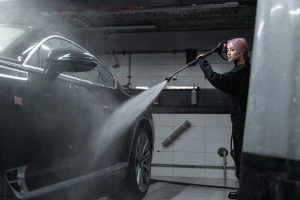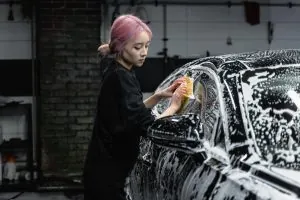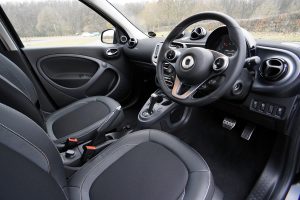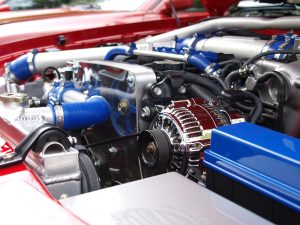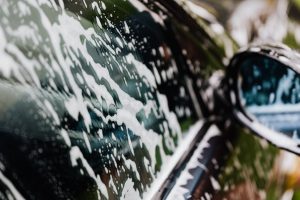Contents
- The Ultimate Guide: How to Keep Your Car Clean and Pristine
- Importance of a Clean Car
- Exterior Car Cleaning
- Interior Car Cleaning (how to clean a car interior)
- Regular Maintenance for a Cleaner Car
- Essential Tools and Supplies
- Troubleshooting Common Cleaning Challenges
- Pro Tips for a Showroom-Ready Finish
- What to use to clean inside of car dashboard?
- Professional car detailing supplies
- What household products can i use to clean the inside of my car?
- Conclusion
- FAQs
The Ultimate Guide: How to Keep Your Car Clean and Pristine
Keeping your car clean is not just about appearances; it’s also essential for maintaining its value, preventing damage, and ensuring a comfortable driving experience.
In this comprehensive guide, we’ll delve into the best practices and tips to help you keep your car sparkling clean.
From regular maintenance routines to tackling tough stains and odors, we’ll cover it all. Let’s dive in and discover the secrets to maintaining a pristine car!
Importance of a Clean Car
Maintaining Value and Appearance: A clean car holds its value better and has a higher resale potential.
Regular cleaning and detailing preserve the paint, prevent rust, and maintain the overall aesthetics of your vehicle.
Car cleaning is that important…
Enhancing Safety: A clean windshield and windows provide optimal visibility, ensuring a safe driving experience.
Additionally, keeping headlights and taillights clean improves their effectiveness and visibility on the road.
Improving Comfort and Well-being: A clean car interior promotes a pleasant driving environment.
Eliminating dust, allergens, and odors enhances air quality and reduces health risks. A clutter-free cabin also reduces distractions and allows for a more relaxing journey.
Exterior Car Cleaning
Washing and Drying Techniques: Use a gentle car wash soap, a microfiber mitt, and a two-bucket method to avoid swirl marks.
Rinse thoroughly and dry with a microfiber towel or a drying aid to prevent water spots.
Choosing the Right Products: Select car-specific cleaning products that are safe for your vehicle’s surfaces.
Using the correct product is important whether that is the engine oil, filter, or any other part of your vehicle.
Be mindful of the paint type, and use appropriate cleaners for wheels, tires, and glass.
Protecting the Paint and Clear Coat: Apply a quality wax or paint sealant to protect the paint from UV damage, contaminants, and minor scratches.
Regularly inspect and touch up any damage or chips to prevent further deterioration.
Maintaining the Wheels and Tires: Clean wheels and tires not only enhance the overall appearance but also contribute to their longevity.
Use wheel brushes and appropriate cleaners to remove brake dust and grime.
Apply a tire dressing for a sleek finish and added protection.
Cleaning Glass Surfaces: Use a glass cleaner and lint-free microfiber cloth to clean the windows, mirrors, and windshield.
Ensure streak-free results by working in small sections and using a circular motion.
Waxing and Polishing for a Glossy Finish: Regular waxing and polishing help maintain a glossy and protected exterior.
Apply a high-quality car wax or paint sealant to enhance shine and provide a protective barrier against environmental elements.
Interior Car Cleaning (how to clean a car interior)
Removing Trash and Clutter: Start by removing any trash, empty bottles, and unnecessary items from the car.
Use storage organizers to keep essential items organized and prevent clutter.
Vacuuming Carpets and Upholstery: Utilize a vacuum cleaner with various attachments to thoroughly clean the carpets, floor mats, and upholstery.
Pay attention to crevices and hard-to-reach areas where dirt and debris tend to accumulate.
Cleaning and Conditioning Leather: For leather interiors, use a leather cleaner and conditioner to remove dirt, nourish the leather, and prevent cracking.
Follow the manufacturer’s instructions for the best results.
Freshening Up the Dashboard and Interior Surfaces: Use a gentle interior cleaner to wipe down the dashboard, center console, door panels, and other surfaces.
Microfiber cloths or detailing brushes can help reach tight areas and remove dust effectively.
Windows and Mirrors: A Crystal Clear View: Clean the interior windows and mirrors using a glass cleaner and lint-free cloth. Remove fingerprints and streaks for a clear view while driving.
Dealing with Lingering Odors: To eliminate odors, use odor-neutralizing sprays or air fresheners specifically designed for cars.
Consider using odor-absorbing products like activated charcoal or baking soda to tackle persistent smells.
Regular Maintenance for a Cleaner Car
Setting Up a Cleaning Schedule: Create a regular cleaning schedule that includes both interior and exterior maintenance.
Stick to the schedule to ensure your car remains consistently clean.
Preventing Stains and Damage: Take preventive measures to avoid stains and damage. Use floor mats and seat covers to protect the upholstery.
Be cautious with food and drink consumption in the car, especially with potentially staining items.
Protecting the Car’s Interior: Apply fabric protectants or leather conditioners to create a barrier against spills and stains.
Consider using UV protectant sprays for plastic and vinyl surfaces to prevent fading and cracking.
Weatherproofing for All Seasons: Adjust your cleaning routine based on seasonal challenges. In winter, focus on salt and mud removal, while in summer, protect against sun damage and overheating.
Seasonal Maintenance Tips: Perform thorough cleanings and inspections at the start of each season.
Check for any signs of wear or damage and address them promptly.
Replace worn wiper blades, check tire pressure, and perform routine maintenance tasks.
Essential Tools and Supplies
Car Wash Equipment: Invest in a good-quality hose, bucket, and microfiber wash mitts for efficient car washing.
Consider a pressure washer for a more thorough cleaning.
Cleaning Products and Solutions: Choose car-specific cleaners for different surfaces such as paint, wheels, glass, and interior.
Opt for pH-neutral products to protect sensitive areas.
Brushes, Cloths, and Applicators: Have a variety of detailing brushes, microfiber cloths, foam applicators, and soft-bristle brushes to clean different parts of your car effectively.
Vacuum Cleaners and Steamers: Invest in a powerful vacuum cleaner that comes with various attachments to clean carpets, upholstery, and hard-to-reach areas.
Steam cleaners can also be useful for deep cleaning and sanitizing surfaces.
Air Fresheners and Odor Eliminators: Choose air fresheners or odor eliminators specifically designed for cars.
Consider options like vent clips, hanging sachets, or sprays to keep your car smelling fresh.
Troubleshooting Common Cleaning Challenges
Removing Stubborn Stains and Spills: Different stains require specific treatment. For example, use a carpet stain remover for spills on carpets or upholstery.
Research appropriate stain removal techniques and products for different surfaces and stains.
Dealing with Pet Hair: Use a rubber glove, lint roller, or specialized pet hair removal tool to remove pet hair from seats and carpets.
Vacuuming with a pet hair attachment can also help eliminate embedded fur.
Eliminating Lingering Odors: For persistent odors, consider using odor-neutralizing sprays, charcoal-based air purifiers, or baking soda.
Deep cleaning carpets and upholstery, as well as regularly changing cabin air filters, can also help tackle unpleasant smells.
Tackling Mold and Mildew: Use a mixture of water and vinegar or an anti-mold spray to address mold and mildew growth.
Scrub affected areas gently and ensure proper ventilation to prevent regrowth.
Restoring Cloudy Headlights: Headlight restoration kits and specialized polishes can help remove oxidation and restore clarity to cloudy headlights.
Follow the instructions provided in the kit for the best results.
Pro Tips for a Showroom-Ready Finish
Preparing Your Car for Cleaning: Start by removing personal belongings, trash, and larger debris from the car.
Pre-rinse the exterior before washing to remove loose dirt and grime.
Open the windows for ventilation during interior cleaning.
Adopting Efficient Cleaning Techniques: Work in sections to avoid leaving any areas uncleaned.
Use the appropriate tools and products for each surface.
Follow a top-to-bottom and left-to-right approach for a systematic and thorough cleaning process.
Avoiding Common Mistakes: Avoid using harsh household cleaners or abrasive tools that can damage your car’s surfaces.
Do not wash your car under direct sunlight or in extreme weather conditions.
Avoid using excessive force when cleaning to prevent scratching.

Protecting Your Car’s Interior and Exterior: Regularly apply protective products such as wax, paint sealant, and fabric/leather protectants to shield your car from environmental elements and preserve its condition.
Seeking Professional Detailing Services: Professional car detailing can provide deep cleaning and specialized treatments that may be challenging to achieve at home.
Consider professional detailing services for periodic maintenance and restoration of your car’s appearance.
What to use to clean inside of car dashboard?
To clean the inside of a car dashboard, you can use a gentle interior cleaner that is safe for the dashboard’s materials.
Apply the cleaner to a microfiber cloth and wipe the dashboard, paying attention to any stubborn spots or stains.
Use a soft-bristle brush or detailing brush to remove loose dirt and debris before cleaning.
Remember to read and follow the instructions provided by the cleaner’s manufacturer for the best results.
Professional car detailing supplies
Professional car detailing supplies include car wash soap, microfiber towels, clay bars, polishing compounds, dual-action polishers, foam pads, paint sealants and waxes, interior cleaners, upholstery and carpet cleaners, glass cleaners, and detailing brushes.
What household products can i use to clean the inside of my car?
ou can use household products like vinegar and water solution for glass cleaning, baking soda for odor removal, and mild soap and water solution for general interior cleaning.
In addition to the household products mentioned earlier, you can also use a mixture of mild dish soap and warm water to clean surfaces like plastic, vinyl, and upholstery.
For tougher stains, you can make a paste using baking soda and water and apply it to the affected area before scrubbing gently with a soft brush or cloth.
Vinegar diluted with water can also be used to remove stains and disinfect surfaces.
Additionally, a handheld vacuum or a regular vacuum with attachments can effectively remove dirt and debris from carpets and upholstery.
Remember to always test any cleaning solution on a small, inconspicuous area before applying it to the entire surface.
Conclusion
By following the tips and techniques outlined in this guide, you’ll be well-equipped to keep your car clean and maintain its pristine condition.
Remember that regular cleaning and maintenance not only enhance the appearance of your vehicle but also contribute to its longevity and overall driving experience.
So, roll up your sleeves, gather your cleaning supplies, and get ready to showcase a spotless, well-cared-for vehicle that turns heads on the road.
Your car deserves the best, and with these expert tips, you can achieve just that!
FAQs
Q. How do I deep clean the inside of my car? A. Deep cleaning the inside of your car involves thorough cleaning and addressing hard-to-reach areas. Here's a step-by-step guide: 1. Remove all personal items and trash from the car. 2. Vacuum the carpets, upholstery, and floor mats to remove loose dirt and debris. 3. Use a gentle interior cleaner or fabric-specific cleaner to clean surfaces like the dashboard, center console, door panels, and seats. 4. Pay attention to crevices and hard-to-reach areas using detailing brushes or cotton swabs. 5. Clean the windows, mirrors, and windshield using a glass cleaner and lint-free cloth. 6. For leather upholstery, use a leather cleaner and conditioner to remove dirt and maintain the leather's quality. 7. Freshen up the interior by using an air freshener or odor eliminator specifically designed for cars. Remember to follow the instructions on the cleaning products and use appropriate tools for different surfaces. Q. How to properly clean your car? A. Properly cleaning your car involves a systematic approach to ensure thorough cleaning and protect the vehicle's surfaces. Here are the essential steps: 1. Start by rinsing the exterior to remove loose dirt and debris. 2. Use a gentle car wash soap and a microfiber wash mitt to wash the exterior in sections. 3. Rinse thoroughly and dry the car using a microfiber towel or a drying aid to prevent water spots. 4. Clean the wheels and tires using appropriate wheel brushes and cleaners. 5. Clean the glass surfaces with a glass cleaner and a lint-free cloth. 6. Apply a wax or paint sealant to protect the paint and provide a glossy finish. 7. Vacuum the interior, including carpets, upholstery, and floor mats, to remove dirt and debris. 8. Clean the dashboard, center console, and other surfaces using a gentle interior cleaner. 9. Use appropriate cleaners and conditioners for leather upholstery. 10. Clean the windows, mirrors, and windshield using a glass cleaner and lint-free cloth. 11. Address any lingering odors with an air freshener or odor eliminator specifically designed for cars. Remember to use the right tools and products for each surface, work in sections, and avoid using excessive force that may cause damage. Q. What do professionals use to clean car interior? A. Professionals often use a combination of specialized tools and products to clean car interiors. Some commonly used tools include: 1. Powerful vacuum cleaners with various attachments to clean carpets, upholstery, and hard-to-reach areas. 2. Detailing brushes of different sizes to clean crevices, vents, and other tight spaces. 3. Steam cleaners for deep cleaning and sanitizing surfaces. 4. Microfiber cloths and towels for wiping and drying surfaces without scratching. 5. Air compressors or compressed air blowers for removing dust from hard-to-reach areas. Regarding cleaning products, professionals may use: 6. Interior cleaners are specifically formulated for different surfaces like plastic, vinyl, and fabric. 7. Leather cleaners and conditioners for leather upholstery. 8. Glass cleaners for streak-free cleaning of windows, mirrors, and windshields. 9. Odor-neutralizing sprays or air fresheners designed for cars. Professional-grade products may vary, and the choice depends on the specific needs and preferences of the detailing service. Q. What cleans cars the best? Q. What cleans cars the best? A. Several cleaning products are known for their effectiveness in cleaning cars. Here are some commonly used and highly regarded options: 1. Car Wash Soap: Choose a high-quality car wash soap specifically formulated for automotive use. Look for pH-neutral soaps that effectively remove dirt without damaging the paint or protective coatings. 2. Microfiber Towels: Microfiber towels are excellent for cleaning and drying cars. They are soft and lint-free, making them ideal for preventing scratches and streaks while providing efficient cleaning and drying. 3. All-Purpose Cleaner: An all-purpose cleaner can be used for various surfaces inside the car, including the dashboard, door panels, and upholstery. Look for a cleaner that is safe for different materials and provides effective cleaning without leaving residue. 4. Glass Cleaner: A high-quality glass cleaner is essential for achieving crystal-clear windows and mirrors. Choose a streak-free formula that removes dirt, fingerprints, and smudges without leaving any residue or haze. 5. Wheel and Tire Cleaner: Specifically formulated wheel and tire cleaners help remove brake dust, grime, and road debris from wheels and tires. Look for products that are safe for different wheel finishes and effectively clean and restore the appearance of tires. 6. Interior Protectants: Interior protectants help maintain the condition of various surfaces inside the car, such as plastic, vinyl, and rubber. They provide UV protection, prevent fading and cracking, and leave a non-greasy, natural-looking finish. 7. Upholstery and Carpet Cleaner: For deep cleaning carpets and upholstery, choose a dedicated upholstery and carpet cleaner. Look for a product that effectively lifts and removes stains, dirt, and odors without causing damage or leaving residues. 8. Clay Bar: A clay bar is a useful tool for removing embedded contaminants from the paint surface, such as industrial fallout, tar, and tree sap. It provides a smooth, clean surface and prepares the paint for waxing or sealing. 9. Wax or Sealant: Applying a quality car wax or paint sealant is crucial for protecting the paint and providing a glossy finish. Choose a product that offers long-lasting protection against UV rays, oxidation, and environmental contaminants. 10. Detailing Spray: A detailing spray is a versatile product that can be used for quick touch-ups, lubrication during clay bar usage, or as a drying aid after washing. It enhances shine, adds hydrophobic properties, and provides a protective layer between washes. Remember to read and follow the instructions provided by the manufacturers of these products for optimal results. Additionally, using high-quality tools such as soft-bristle brushes, foam applicators, and detailing brushes can further enhance the effectiveness of the cleaning process.
